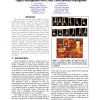Free Online Productivity Tools
i2Speak
i2Symbol
i2OCR
iTex2Img
iWeb2Print
iWeb2Shot
i2Type
iPdf2Split
iPdf2Merge
i2Bopomofo
i2Arabic
i2Style
i2Image
i2PDF
iLatex2Rtf
Sci2ools
CVPR
1999
IEEE
1999
IEEE
Object Recognition with Color Cooccurrence Histograms
We use the color cooccurrence histogram (CH) for recognizing objects in images. The color CH keeps track of the number of pairs of certain colored pixels that occur at certain separation distances in image space. The color CH adds geometric information to the olor histogram, which abstracts away all geometry. We compute model CHs based on images of known objects taken from different points of view. These model CHs are then matched to subregions in test images to find the object. By adjusting the number of colors and the number of distances used in the CH, we can adjust the tolerance of the algorithm to changes in lighting, viewpoint, and the flexibility of the object. We develop a mathematical model of the algorithm's false alarm probability and use this as a principled way of picking most of the algorithm's adjustable parameters. We demonstrate our algorithm on different objects, showing that it recognize objects in spite of confusing background clutter, partial occlusions,...
Certain Separation Distances | CH Keeps Track | Color Ch | Color Cooccurrence Histogram | Computer Vision | CVPR 1999 | Model Chs |
| Added | 12 Oct 2009 |
| Updated | 12 Oct 2009 |
| Type | Conference |
| Year | 1999 |
| Where | CVPR |
| Authors | Peng Chang, John Krumm |
Comments (0)

